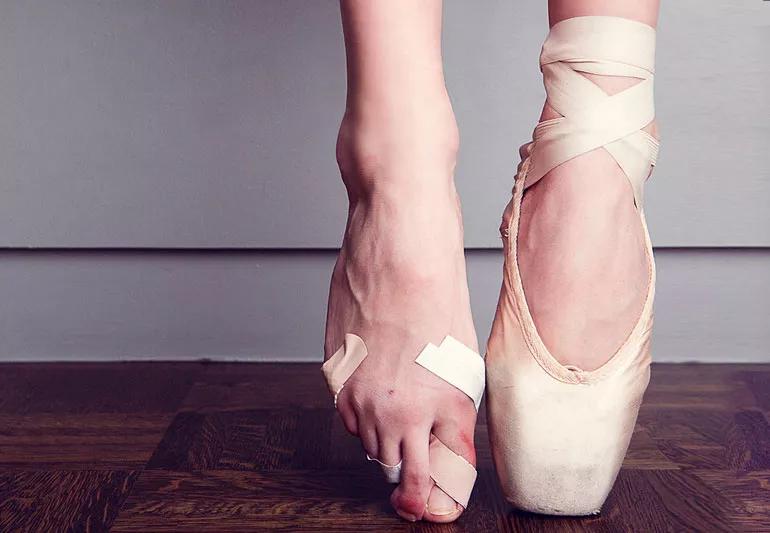Poorly fitting footwear and overuse injuries can knock you ‘off pointe’

From the audience’s view, a ballerina dancing seems almost effortless.
Advertisement
Cleveland Clinic is a non-profit academic medical center. Advertising on our site helps support our mission. We do not endorse non-Cleveland Clinic products or services. Policy
But the truth is, each step, move and position takes a great deal of effort, precision and skill. And as any dancer who’s trained in ballet will tell you, this dance style requires an immense amount of strength and coordination from your feet.
Aside from the potential for different types of injuries, years of ballet training can also cause your feet to change over time or even become malformed — often referred to as “ballerina feet.” If you’ve been dancing all your life, you may have even heard this phrase used with a sense of pride.
But years of ballet dancing come with risks, so it’s important to make sure you’re taking good care of your feet.
Sports physical therapist Jessica Waters, DPT, explains how ballet changes your feet over time, as well as how you can avoid injury or long-term damage.
Ballerina feet — also known as ballet dancer’s feet — isn’t an official medical diagnosis, but the term refers to the physical effects that result from the intense training and demands of ballet dancing. This can happen due to many elements involving the art of ballet, from footwear to specific techniques and positions.
Some of the common, more visual changes of ballerina feet include:
Advertisement
These changes typically happen due to poorly fitting footwear, improper training conditions and practices, and intense performances.
Beyond just external damage and aesthetic disfigurations, there are also severe injuries that many ballet dancers are prone to, which can also play a part in affecting your foot health long term.
Some examples of long-term damage that can be caused due to incorrect technique during ballet training include:
The very art of ballet relies on dancers knowing proper technique, strength and balance in order to perform movements properly. Excessive stress is placed on the foot due to various positions or poor technique at the hip and knee. This in turn can lead to injuries and strains on the foot.
“If you compare across genres, ballet is documented to have predominantly foot and ankle injuries,” notes Dr. Waters.
Further, the stress that a ballet dancer’s feet can go through can happen due to either overuse or specific injuries — or a combination of both.
According to Dr. Waters, one of the biggest differences between ballet and other sports is that there’s a higher risk of overuse injuries. This is when a part of the body (in this case, the foot) gets pushed to its limit physically, without enough time to recover.
Common ballet positions that put strain on your feet include:
Advertisement
Aside from overuse, there’s also a risk of injuries happening due to specific traumatic falls — say, a move goes wrong and a dancer takes a tumble or twists their foot in the wrong direction. A lot of times, this happens due to a dancer landing incorrectly from a move or something being wrong with their footwear.
“Placing your center of mass on a 2-inch square space can lead to ankle sprains and various injuries,” explains Dr. Waters. “There is a lot of load through the tissues in this position.”
Ballet dancers are usually at risk for an array of foot injuries, including foot fractures, ankle sprains and torn ligaments. But as Dr. Waters notes, often, these specific traumatic injuries are closely tied to problems of overuse in the foot. “Sometimes, those overuse injuries had an acute incident that wasn’t managed.”
This may happen because ballet dancers may feel pressured not to skip any practice or rehearsal, even if they’re experiencing pain. In addition, many dancers aren’t able to use braces or orthotics because of costumes, footwear and artistic requirements.
One of the most unique elements of ballet is the shoes. For dancers who specifically practice the pointe technique, they must wear pointe shoes, which are usually made of satin, leather and cotton. Compared to other dance shoes, pointe shoes provide a specific type of support for dancers to be able to do certain challenging moves because of the toe box. This is the part of the shoe that holds the dancer’s toe and provides a platform to be able to balance on their toes.
Advertisement
But as Dr. Waters points out, “Pointe shoes come with their own inherent risk as far as foot and ankle injury goes. The shape of your foot will determine the shape of your toe box.” So, it’s very important this is taken into account when choosing your pointe shoes. “If you have a wider foot, but select something that’s more narrow, that can have ramifications that can lead to things like bunions,” she continues.
Plus, if your shoes don’t fit right, this can cause you to lose control during routines and lead to ankle or foot injuries. Consistent stress from pointe shoes — especially if unaddressed — can lead to long-term damage and serious injury.
Just like with any sport or intense physical activity, proper foot care and technique are absolutely key in making sure that your feet stay healthy and supported. A ballet dancer’s feet require a good amount of TLC and attention to avoid injuries and relieve stress and pain.
Dr. Waters lays out ways to lessen your risk of pirouetting into any foot injuries while dancing:
Advertisement
If you’re a seasoned dancer, you probably have an immense amount of patience and self-discipline for performing. But it’s also incredibly important to take note when any symptoms are becoming more severe and pointing to a bigger issue. The important thing is to check in with your body after each routine or practice.
Be sure to see your healthcare provider or physical therapist if you experience any of the following symptoms:
Here’s the bottom line: If you’re a ballet dancer, chances are your feet are going through a fair amount of stress. But it’s important to know the proper techniques and self-care practices to do so you can stay “en pointe” — both through your dance routine and with your overall foot health. Be sure to keep your healthcare provider updated with any changes, pains or concerns you may have with your feet as you continue your practice.
Learn more about our editorial process.
Advertisement

Try seated and standing exercises to help lengthen and strengthen the muscles that support your plantar fascia

Home remedies are unlikely to cure your contagious foot fungus — and they might even make it worse

Cramps can creep up if your shoes are too tight, you’re dehydrated or you have poor circulation

If soaking your feet, disinfecting your shoes and making lifestyle changes don’t do the job, it’s time to talk to a doctor

Genetics, hormones, medications and stress are just a few reasons your feet could be extra funky

Try stretching, massage, elevation and a supportive pair of shoes to help relieve foot aches and pains

Footwear that offers cushioning plus heel and arch support can help you relieve and manage symptoms

Except in certain medical scenarios, foot health experts rarely recommend foot soaks

Babies can get congested easily, but you can calm their cough by keeping them hydrated, using nasal drops and running a humidifier

Weight loss may cause loose, sagging skin and muscle loss to your rear

Several conditions, like vitiligo and fungal infection, can cause a loss of pigmentation, leading to white spots or patches on your skin